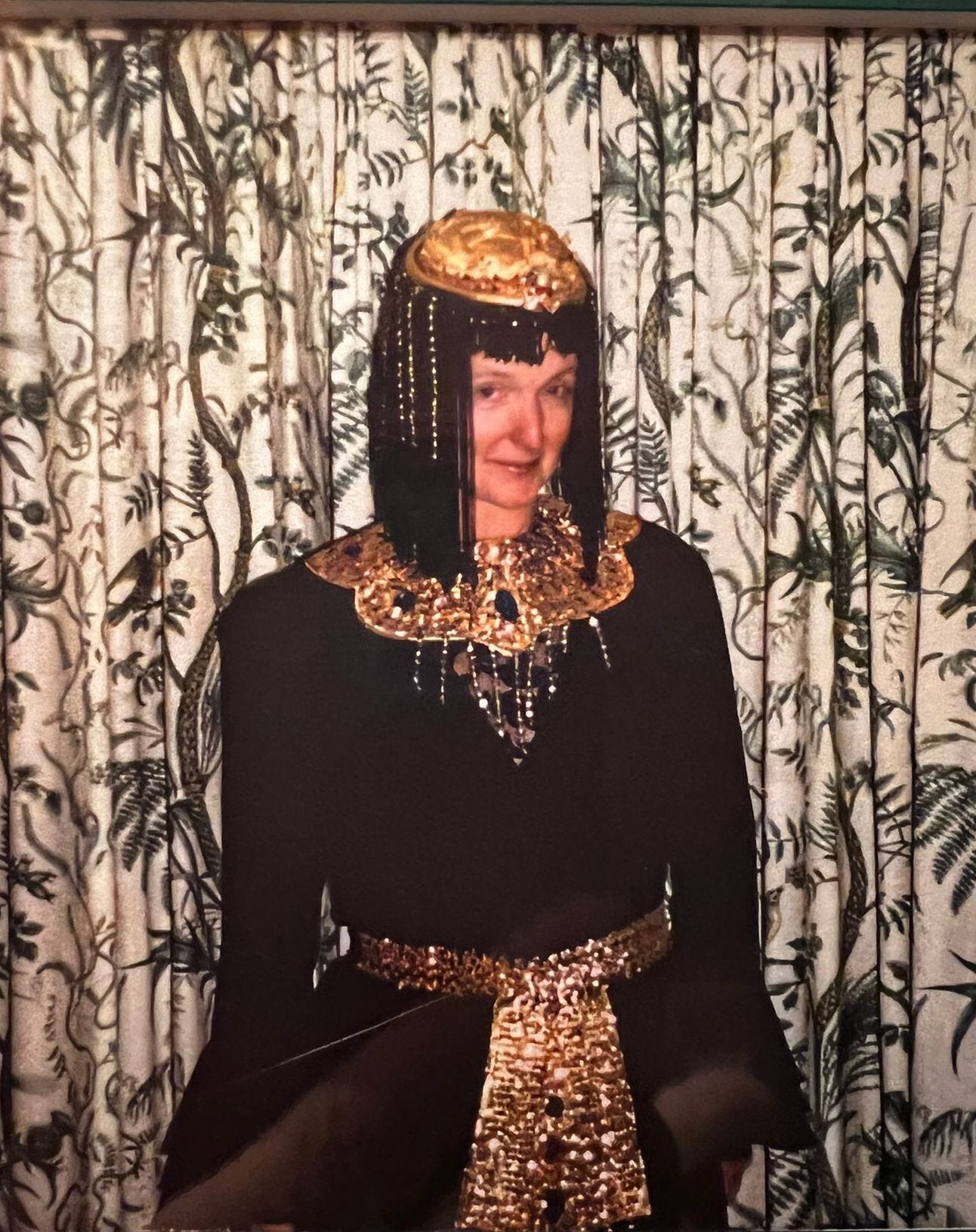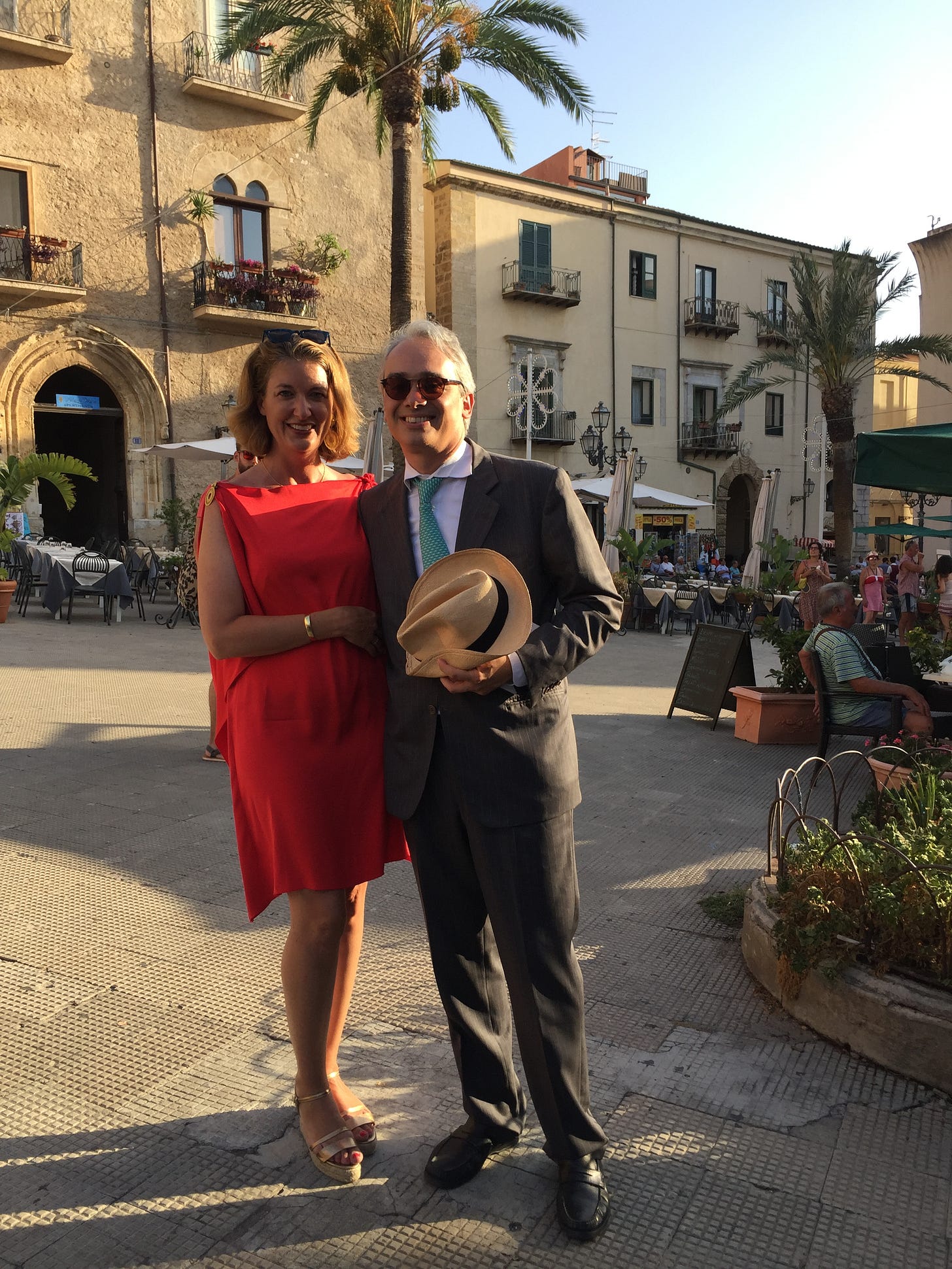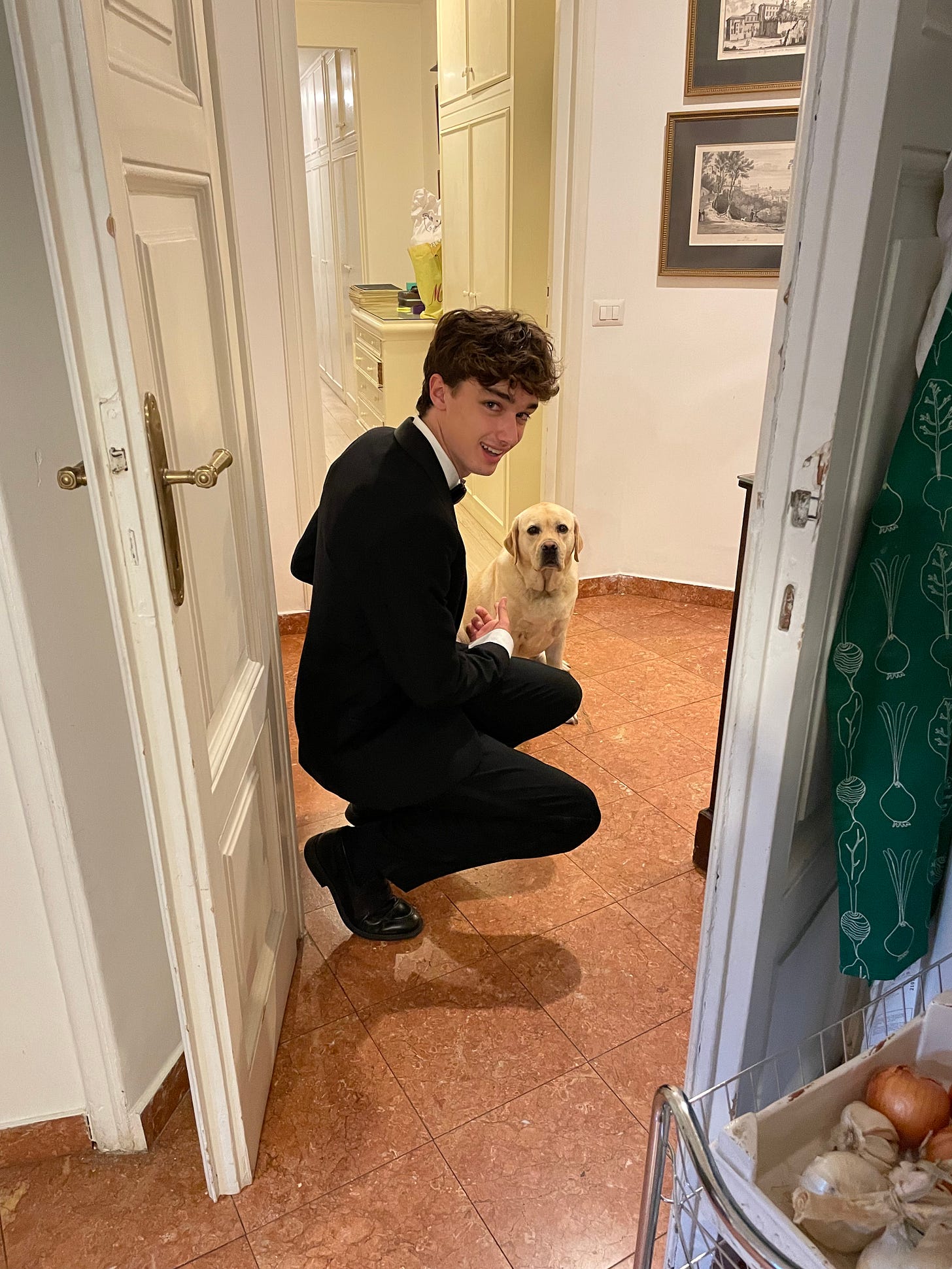What does "casual chic" mean in Italy?
A popular dress code in Rome led us to interpret style in our own American way.
Just because Italians toss around phrases in English doesn’t mean Americans understand them. Take “casual chic.” We found out the hard way.
It started with an invitation for my 16-year-old son this past summer. When you’re sixteen in Rome, you aspire to be invited to a Diciottesimo, the equivalent of a Sweet Sixteen party in the United States but, instead, for eighteen-year-olds. The younger you are when invited to an older kid’s party the cooler and more mature you feel. It’s that rite-of-passage-party between high school and college where kids let loose and parents don’t exhale until their kids walk through the door, usually around 4am.
Newly returned to Italy after spending the past five years in San Francisco, my son Luca is navigating the social waters of an active, Roman nightlife for teenagers. And, so am I, while wringing my hands.
We’ve had to have a few conversations to clarify the differences in laws and customs between America and Italy. An international move from one country to the other as a teenager can be confusing. In California, it’s legal to buy or smoke cannabis at 18 (with a doctor’s prescription) but illegal to drink or buy alcohol where the drinking age is 21-years-old in the United States. In Rome, it’s illegal to buy or smoke cannabis as a teenager and the drinking age is 18 (but wine is often consumed by youngsters at family dinners as an enhancement to a meal). In 2012, the Health Ministry in Italy changed the drinking age from 16- to 18-years-old, fines were enacted to those selling alcohol to someone under 18, and serving alcohol to anyone under 16 became a criminal offense, with up to a year in prison.
Insomma, there’s stuff to digest as an Italian-American teenager living in Italy. Even the dress codes are a tad complicated.
For the past year, we have been observing the Instagram posts of Luca’s older cousins, who live in Milan, as they attended the sorts of parties to which he was suddenly invited. Filmed stories upon stories flashed through our accounts of kids dressed up for a sort of Prêt-à-Porter Prom — young women in long, slinky, formal dresses in skyscraper heels, and young men in Black Tie in lace-up orchestra shoes. Think The Great Gatsby, not Sixteen Candles.
It was thanks to his Milan cousins that my son received the invitation to this party in Rome. Even though he didn’t know the guest of honor or any of his friends, the privilege of being invited to a truly teenage party, thanks to a friend of a friend, was huge. It was a slam-dunk, immediate-but-let’s-try-to-tone-down-our-enthusiasm, sì sì, sìììì, grazie, grazie, grazieeeee when it came time to RSVP. Unfortunately, Luca’s cousins wouldn’t be able to attend the party from Milan but Luca was cool to go on his own. He felt confident that he’d run into someone he knew. If not, he embraced the idea of meeting new people, and dressing up for a party.
He looked dapper in his father’s old Black Tie which we had tailored to fit him. With his shoes shined, suit pressed, cufflinks clipped, and silk pocket scarf flapping near his lapel, he kept trying to avoid our Labrador who wanted to shimmy next to his shins and shed half her yellow fur coat on his black pant-legs.
His sister and I drove him to the meeting point where two coach buses waited to drive at least 150 teenagers to the party venue villa outside of the city. The drop-off spot was referred to as GNAM on the invitation. All I know “gnam” to be in Italian is an onomatopoeic interpretation of “yum” so I imagined I’d leave him in front of a Roman restaurant specializing in carbonara. After asking around to regulars on the party circuit, I discovered it was the Galleria Nazionale d’Arte Moderna (GNAM). Duh.
We parked the car discretely across the street so that we could spy on the guests before he got out of the car. It was blistering hot on that September, Roman night, and we had turned up the air conditioning so he’d remain cool in his heavy suit.
Once we saw the guests, all three of us started to sweat.
No one was dressed in Black Tie. Not. A. Soul.
Luca and I looked at each other and, through expletives in operatic Italian and English, both shrieked, “What was the dress code??!!”
With our hearts beating, we flipped through our WhatsApp accounts to find the invitation. We read the verdict: CASUAL CHIC.
We didn’t know if we should laugh or cry.
We were completely at fault, as neither of us had read the fine print. We had assumed that all Diciottesimi parties had the same dress code as those of his cousins’ in Milan: Black Tie. Those guests had looked like actors in old-fashioned Italian movie reels: dashing mini Marcello Mastroiannis and Vittorio De Sicas.
It had never even occurred to us that this party wouldn’t be Black Tie. This was Italy, after all. No one is EVER dressed casual. How could this be?!
Through the car window, slinking deeper into our seats, we spied from afar on what it meant to be casual chic: All the boys were dressed in solid color linen shirts — blue, dark green or white — and either blue or beige trousers with a leather belt. No blazers, no ties. Comfortable, leather loafers. Luca was dressed as if he were about to get married; these guys looked like they were about to attend a Sunday brunch. Even though Luca has an entire closet full of this casual chic uniform, we couldn’t pull it off with the timing of the evening. The buses were due to leave any minute. We had showed up casually late, not casually chic.
I spent the next ten minutes convincing Luca that it was better to be overdressed for a party than underdressed. I quickly told him about the time my mother attended a Manhattan dinner party (convinced it was a costume party) dressed as Cleopatra (complete with a beaded wig and gold armor collar with a matching sequined-sash) among a snickering crowd of anorexic socialites dressed in little black dresses. And then I reminded him of the time I picked him up from school on St. Patrick’s Day in San Francisco after a fancy luncheon, still dressed in pearls, high heels and an emerald-green silk pant suit — and his classmate told me I was dressed in the best Leprechaun costume he’d ever seen.

Luca was suddenly pink. He took a few deep breaths, channeling in his goalkeeper training before a penalty kick. He loosened and then removed his bow tie — stuffed it into the glove compartment. He threw his silk pocket scarf on the dashboard. He unbuttoned his white dress shirt, and tousled his hair. He opened the car door, slammed it, and stormed across the street to the sea of linen shirts, chinos, and penny loafers. By his gait, it was clear: he was not going to miss his first Diciottesimo. My daughter and I marveled as we watched him mingle, standing out like a penguin.
He came back home at 3am, happy and chuckling. My face fell when I saw that he was missing the top half of his outfit — he had lost his velvet-lapeled jacket. But, before I said anything, I thought about how he must have felt: he probably couldn’t wait to strip down to a more casual look, to shed formality among the informally-dressed guests, to feel lighter in torrid weather. He may have lost his jacket but he hadn’t lost his cool.
Eventually, a few days later, the top half of his Black Tie suit was returned as someone had mistaken it as his own. I like to think maybe someone else had envied his look and tried to steal it. Maybe even wore it over jeans. Casual chic, right?
As far as I can see, there’s no casual here in Rome, only chic. Even my plumber shows up in crisp dress shirts and stylish, pressed trousers. In my eyes, Italians always look casual chic so how is dressing for an occasion any different than the way they dress during the day?
I decided to ask a dear Milanese friend of mine who has been covering fashion for Il Corriere della Sera for the past 20 years. If there’s anyone who is an expert of style and dress codes in Italy, it’s Paola Pollo. She confirmed that there are numerous dress codes in Italy, and all of them are referred to in English: among them are Black Tie, Cocktail, Casual Chic, Casual, Smart Casual, and, my favorite, Yacht Man.
The dress codes, she said, are set mostly for men and they are quite straight-forward — so men know whether or not to wear a coat and tie, a blazer, Black Tie, jeans, sneakers, dress shoes or not. Casual chic in Rome is just as we had seen at the party scene — but the older set (beyond 18) might wear a blazer (no tie).
Whereas women have more flexibility in making an outfit look casual chic: a silk blouse over flowy trousers with sandals or a dress with designer sneakers, for instance. And it’s how women wear what they choose to wear, according to Pollo: sharper shoes than those reserved for the office or a ruffled blouse over palazzo pants. In essence, dressed casual chic, you should look like you’ve changed after the office into a more comfortable, relaxed look but you’re not going out to dance.
At least twice a week, I drive my son to school in what used to be my usual San Francisco morning outfit of athletileisure clothes — leggings, a sweatshirt and running shoes — so that I can then take a brisk walk comfortably with my dog in the nearby Villa Borghese. Often, I head to the supermarket afterwards. From the looks I get from the customers and cashiers already dressed to the nines by nine, I’m far too casual for daily life in Rome and nowhere near chic. I do spot some Italians dressed as I am but, unlike me, their sporty outfits always flash some sort of a brand and their stylish sneakers match it.
My daughter recalls that it was her first-grade teacher at her Roman elementary school who first introduced her to casual chic. Every day, her teacher arrived at 8am from her home in Napoli, after an hour and a half train ride to Rome. With her face painted like a make-up artist’s and her hair coiffed in flowing beach waves, she usually wore legging jeans, a revealing, red V-neck sweater with a double-breasted blazer, and red, stiletto heels. She would click-click-click-click up the imposing staircase of the public school, and greet her young students as if she were about to go onstage. A Roman Mr. Rogers, she went through the daily routine of slipping out of her stilettos into a more grounding pair of Superga sneakers before school began. My daughter would occasionally sneak a peek of her pedicured toes which often matched her high heels. At the end of the day, when the bell rang to signify dismissal, her teacher unlaced her Supergas, repositioned them in her closet next to the blackboard, and slipped back into her stilettos. She would click-click-click-click down the marble steps like Sophia Loren descending a staircase, teetering over toddlers and tykes, and hoof it back to Napoli on the commuter train. Nailing it in casual chic.
The look also goes hand-in-hand, as most things in Italy do, with la bella figura, the act of looking, dressing and behaving a certain way to maintain a sense of gracious decor and natural politesse.
Several summers ago, I found myself put to the test of la bella figura wrapped up with casual chic at a friend’s wedding in Cefalù, Sicily. I can’t even remember the dress code: probably Survival Chic as it was hotter than hell in mid-August. I wore a red, sleeveless, knee-length dress made out of a bathing-suit-type-fabric, the lightest thing I own which I bought in Tel Aviv where temperatures compete with those of Southern Italy.
While sitting in the Cefalù Cathedral waiting for the bride to enter, we were all dripping with sweat, waving our wedding programs as fans, and hoping to catch the movement of guests walking past us who might offer the relief of a cross-breeze. After leaning down to adjust a sandal strap, I suddenly felt cooler, as if the heat were removed from my chest.
Sure enough, something had changed. I looked down at my lap, and I realized that the stitching of my dress had unraveled from one of its shoulders. My boob — concealed in a lacy black bra — had suddenly crashed the party. It was exposed for all to see, center stage in our pew.
The bride was about to walk in the church. I was smack in the line of vision of the priest who awaited the couple at the altar. There were no straps to my dress that could be retied. I had no pashmina or scarf to cover myself because the scorching heat had prevented me from even considering attaching another piece of fabric to my skin.
The angels of the Cathedral’s 12th-century apse mosaics must have pitied me and sprinkled an idea upon me from above. I was wearing a set of dangly, fake gold earrings the size of two sand dollars, hanging one on top of the other, pierced with a backing. I took one of them out of my ear, and shoved it through one side of the fabric to the other, and clipped the backing to hold the dress together. It seemed strange to be wearing only one earring so, eventually, I removed the other earring from my earlobe and added it to the other shoulder. Voilà.
As the night went on, I even received a few compliments on my dress. One Sicilian, admiring the flashy gold accessories that now served as the keystones that kept my dress on my body, nodded with approval and said, “Love your Vintage Versace.” It was neither vintage nor Versace but I came to think of it as Verace: my true version of Survival Chic.
Like Luca, I tried my best to keep una bella figura and dance the night away in my own interpretation of Casual Chic. By the end of the night, I dove into my pajamas with glee.






Just loved reading this and so clever of you to improvise with the gold earring!
As to your son in his tuxedo: Our oldest son will forever hold it against me that when he was six or so, I made him wear lederhosen (who remembers where we got them?) to a picnic we were hosting. I had erased this from my memory, but later came upon a picture of him in them, so wrote him a formal "Guilty As Charged" letter. Ah well, it's good for character- and empathy-building to occasionally feel out of place. xxx